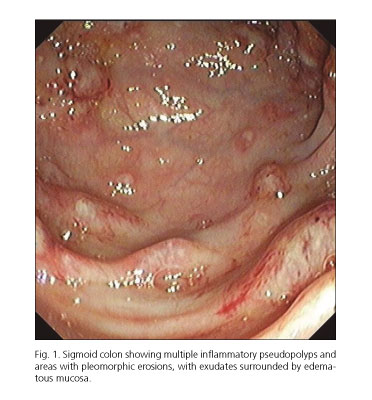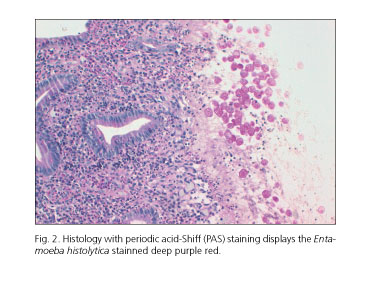My SciELO
Services on Demand
Journal
Article
Indicators
-
 Cited by SciELO
Cited by SciELO -
 Access statistics
Access statistics
Related links
-
 Cited by Google
Cited by Google -
 Similars in
SciELO
Similars in
SciELO -
 Similars in Google
Similars in Google
Share
Revista Española de Enfermedades Digestivas
Print version ISSN 1130-0108
Rev. esp. enferm. dig. vol.109 n.1 Madrid Jan. 2017
PICTURES IN DIGESTIVE PATHOLOGY
All that glitters is not gold. A different cause for an "ulcerative colitis"
Armando Peixoto, Marco Silva, Filipe Vilas-Boas and Guilherme Macedo
Department of Gastroenterology. Centro Hospitalar de São João. Faculty of Medicine. University of Porto. Porto, Portugal
Case report
The authors present the case of a 32-year-old Caucasian male, engineer, who was submitted to a colonoscopy after a presumptive diagnosis of ulcerative colitis. The patient referred an acute bloody and mucous diarrhea, lasting for three weeks, with no fever or rectal tenesmus. Stool studies were negative. During the procedure, colonic segments with continuous hyperemic and exudative mucosa, with small papules with apical ulcers and erosions, were observed (Fig. 1). When specifically asked, the patient revealed that he had returned from a three months stay in Angola in the early days of his symptoms. Biopsies revealed the presence of acute colitis with intense presence of Entamoeba hystolitica (Fig. 2). Treatment with metronidazole for 10 days fully resolved endoscopic and clinical features.
Discussion
Invasive E. histolytica colitis is rare (less than 90% of infected individuals) and marked by loose stools containing blood and mucus (1). However, it remains a major public health problem in developing countries. In Western countries, where the infection is becoming less frequent, it is critical to address in the clinical history of patients with acute diarrhea the existence of recent travel to countries where sanitation facilities and hygiene conditions are poor, and that was the case of our patient. Microscopic examination of stools remains the most widely used method of amebiasis diagnosis, but it requires expertise and lacks sensitivity (2). Colonoscopy should be considered despite non-specific findings, with an identification rate of 70% in biopsy specimens (3). Prompt treatment resolves both symptoms and mucosal lesions within days.
References
1. Ali IK. Intestinal amebae. Clin Lab Med 2015;35:393-422. DOI: 10.1016/j.cll.2015.02.009. [ Links ]
2. Huston CD, Haque R, Petri W. Molecular-based diagnosis of Entamoeba histolytica infection. Expert Rev Mol Med 1999;1999:1-11. DOI: 10.1017/S1462399499000599. [ Links ]
3. Horiki N, Furukawa K, Kitade T, et al. Endoscopic findings and lesion distribution in amebic colitis. J Infect Chemother 2015;21:444-8. DOI: 10.1016/j.jiac.2015.02.004. [ Links ]















